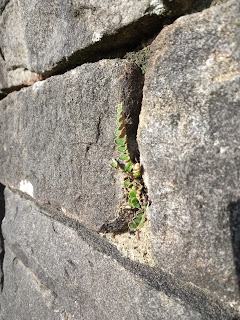Friday 23rd September 2022
Leader: Kay McDowell
We met on the side of the main road A672 near Denshaw which is very close to the vice county boundary with Lancashire. The weather was warm for the time of year, a little breezy with a chance of showers. Our group of five aimed to fill in monad SD9912 which had only one record, may be we would even find a hay-scented buckler-fern (Dryopteris aemula)?
We walked east along footpath towards the reservoir, going off the track to interesting looking habitat. We soon spotted some ferns including some common moorland species including hard fern (Blechnum spicant), lemon-scented fern (Oreopteris limbosperma) and narrow buckler-fern (Dryopteris carthusiana). We headed further down the slope to the beck to investigate an interesting looking bit of damp habitat where we found a nice group of species hare’s-tail cottongrass (Eriophorum vaginatum), opposite-leaved golden-saxifrage (Chrysosplenium oppositifolium) and , as well as the rounded leaves of marsh violet (Viola palustris) and sedges including common sedge (Carex nigra) common yellow-sedge (Carex demissa), star sedge (Carex echinata) and then velvet bent (Agrostis canina) with its leaves trailing down a small waterfall.
After lunch we headed towards the spillway and spotted black spleenwort (Asplenium adiantum-nigrum), and again on the northern dam head with maidenhair spleenwort (Asplenium trichomanes). We walked along the cobbles on the edge of the reservoir, the water level was very low due to the drought. Mike spotted a small unusual form of lady-fern (Athyrium filix-femina) with divided pinnules which he described as a variety called ‘Cristatum’.
 |
| Asplenium adiantum nigum & A trichomanes |
In the drain into the reservoir we spotted Borrer’s scaly male-fern (Dryopteris ssp. borreri) with identification features including square-ended pinnae and ‘chanterelling’ sori. In a pool at the base of a quarry rock face we recorded bog pondweed (Potamogeton polygonifolius) and round-leaved crowfoot (Ranunculus omiophyllus).
We headed towards the Pennine Way to explore a pond marked on the map, but we couldn’t see any aquatic vegetation, so we headed back over the moor to rejoin the footpath. Passing the dam head wall someone spotted a couple of small ferns growing in the cement which turned out to be rustyback (Asplenium ceterach), which made us all very happy. It was the first record for rustyback in hectad SD91! During the trip we recorded twelve ferns.
 |
| Athyrium filix femina 'Cristatum' |
 |
| Asplenium ceterach |
No comments:
Post a Comment